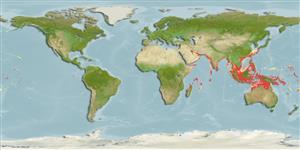Common names from other countries
Environment: milieu / climate zone / depth range / distribution range
Ecologia
; estuarina; intervalo de profundidade 5 - 92 m (Ref. 8). Tropical; 31°N - 18°S, 47°E - 154°W
Indo-Pacific: from Persian Gulf and Arabian Sea to South China Sea and Hawaii.
Length at first maturity / Tamanho / Peso / Idade
Maturity: Lm 11.9, range 10 - ? cm Max length : 22.2 cm TL macho/indeterminado; (Ref. 8); common length : 17.0 cm TL macho/indeterminado; (Ref. 8)
From edge subtidal to depths of 60 m. Prefers mud and sandy-mud bottoms; juveniles found intertidally (Ref. 801). Juveniles are also found in mangrove creeks/inlets, intertidal mud flats, near inshore and far inshore waters (Ref. 121464).
Life cycle and mating behavior
Maturidade | Reprodução | Desova | Ovos | Fecundidade | Larvas
Members of the order Decapoda are mostly gonochoric. Mating behavior: Precopulatory courtship ritual is common (through olfactory and tactile cues); usually indirect sperm transfer.
Holthuis, L.B. 1980. (Ref. 8)
Categoria na Lista Vermelha da IUCN (Ref. 130435)
Categoria CITES (Ref. 108899)
Not Evaluated
Not Evaluated
Utilização humana
Pescarias: altamente comercial
| FishSource |
Ferramentas
Fontes da internet
Estimates based on models
Preferred temperature
(Ref.
115969): 24.8 - 29.1, mean 28.2 (based on 1726 cells).
Resiliência
Elevada, tempo mínimo de duplicação da população menor que 15 meses (K=0.26-2.5; tm=2).
Vulnerabilidade
Low vulnerability (13 of 100).
